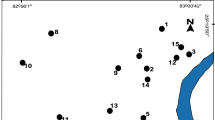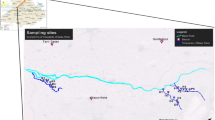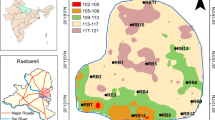Abstract
In the current study, 62 groundwater samples were collected (31 each in premonsoon and postmonsoon seasons) and analyzed for various physicochemical parameters and trace metals in the Trans-Varuna region, Uttar Pradesh. From the cationic fields of piper chart, it is viewed that 78% and 81% samples in premonsoon and postmonsoon, respectively, fall in no dominance type, while all the samples in postmonsoon and 97% samples in premonsoon fall in bicarbonate type in anionic facies. The Ca/Mg ratio with an average of 1.44 and 1.15 in pre-monsoon and post-monsoon correspondingly points out that carbonate dissolution is the leading cause of Ca in the Trans-Varuna region. A plot between [(Na + K) − Cl] and [(Ca + Mg) − (HCO3 − SO4)] suggests that ion exchange also add ions in the groundwater. According to the Gibbs plot, the hydrogeochemistry of samples signifies that most of the samples are from rock dominance. Saturation indices point out that the groundwater of the Trans-Varuna region is saturated with chalcedony, goethite, hematite, and quartz and undersaturated with reference to anhydrite, aragonite, gypsum, halite, and fluorite. 36% sample in premonsoon and 52% samples in postmonsoon shows high NO3 concentration which is above the WHO standard for drinking purpose. In terms of Fe, 74% of samples are beyond the permissible limit of WHO. Various indices to estimate the aptness of groundwater for agricultural function indicate that most of the samples in both the seasons are safe of farming uses. Chronic daily intake values show that infants and children of the investigative region are very vulnerable to nitrate contamination. Target health quotient of heavy metals was established in the sequence of Pb > Zn > Mn > Fe > Ni > Cu.










Similar content being viewed by others
References
Ahamad, A., Raju, N. J., Madhav, S., Gossel, W., & Wycisk, P. (2018). Impact of non-engineered Bhalswa landfill on groundwater from Quaternary alluvium in Yamuna flood plain and potential human health risk, New Delhi, India. Quaternary International.
Alam, M., Rais, S., & Aslam, M. (2012). Hydrochemical investigation and quality assessment of ground water in rural areas of Delhi, India. Environmental Earth Sciences, 66(1), 97–110.
Almadani, S., Alfaifi, H., Al-Amri, A., Fnais, M., Ibrahim, E., Abdelrahman, K., et al. (2017). Hydrochemical characteristics and evaluation of the granite aquifer in the Alwadeen area, southwest Saudi Arabia. Arabian Journal of Geosciences, 10(6), 139.
APHA. (2005). Standard method for examination of water and wastewater (21st ed.). Washington: American Public Health Association.
Arnade, L. J. (1999). Seasonal correlation of well contamination and septic tank distance. Groundwater, 37(6), 920–923.
Berner, E. K., & Berner, R. A. (2012). Global environment: Water, air, and geochemical cycles. Princeton: Princeton University Press.
Central Pollution Control Board (2008) Status of Groundwater Quality in India – Part – II.
Chandran, S., Karmegam, M., Kumar, V., & Dhanasekarapandian, M. (2017). Evaluation of groundwater quality in an untreated wastewater irrigated region and mapping: A case study of Avaniyapuram sewage farm, Madurai. Arabian Journal of Geosciences, 10(7), 159.
Chkirbene, A., Tsujimura, M., Charef, A., & Tanaka, T. (2009). Hydro-geochemical evolution of groundwater in an alluvial aquifer: Case of Kurokawa aquifer, Tochigi prefecture, Japan. Desalination, 246(1–3), 485–495.
Davis, S. N., & DeWiest, R. J. (1966). Hydrogeology (No. 551.49 D3).
Eaton, F. M. (1950). Significance of carbonates in irrigation waters. Soil Science, 69(2), 123–134.
Elangovan, N. S., Lavanya, V., & Arunthathi, S. (2017). Assessment of groundwater contamination in a suburban area of Chennai, Tamil Nadu, India (pp. 1–13). Development and Sustainability: Environment.
Freeze, R. A., & Cherry, J. A. (1979). Groundwater (p. 604). Englewood Cliffs, NJ: Prentice-Hall.
Gibbs, R. J. (1970). Mechanisms controlling world water chemistry. Science, 170(3962), 1088–1090.
Hamzah, Z., Aris, A. Z., Ramli, M. F., Juahir, H., & Narany, T. S. (2017). Groundwater quality assessment using integrated geochemical methods, multivariate statistical analysis, and geostatistical technique in shallow coastal aquifer of Terengganu, Malaysia. Arabian Journal of Geosciences, 10(2), 49.
Hancock, P. J., Boulton, A. J., & Humphreys, W. F. (2005). Aquifers and hyporheic zones: Towards an ecological understanding of groundwater. Hydrogeology Journal, 13(1), 98–111.
Handa, B. K. (1988). Content of potassium in groundwater in India. Fertilizer News, 33(11), 15–27.
Hem, J. D. (1991). Study and interpretation of the chemical characteristics of natural water, 2254 (3rd ed., p. 263). Jodhpur: Scientific Publication.
Huang, G., Sun, J., Zhang, Y., Chen, Z., & Liu, F. (2013). Impact of anthropogenic and natural processes on the evolution of groundwater chemistry in a rapidly urbanized coastal area, South China. Science of the Total Environment, 463, 209–221.
Jalali, M. (2009). Geochemistry characterization of groundwater in an agricultural area of Razan, Hamadan, Iran. Environmental Geology, 56(7), 1479–1488.
Jalali, M. (2010). Groundwater geochemistry in the Alisadr, Hamadan, western Iran. Environmental Monitoring and Assessment, 166(1–4), 359–369.
Jeevanandam, M., Nagarajan, R., Manikandan, M., Senthilkumar, M., Srinivasalu, S., & Prasanna, M. V. (2012). Hydrogeochemistry and microbial contamination of groundwater from lower ponnaiyar basin, cuddalore district, Tamil Nadu, India. Environmental Earth Sciences, 67(3), 867–887.
Kale, S. S., Kadam, A. K., Kumar, S., & Pawar, N. J. (2010). Evaluating pollution potential of leachate from landfill site, from the Pune metropolitan city and its impact on shallow basaltic aquifers. Environmental Monitoring and Assessment, 162(1–4), 327–346.
Kamal, A. K. I., Ahmed, F., Hassan, M., Uddin, M., & Hossain, S. M. (2016). Characterization of textile effluents from dhaka export processing zone (DEPZ) Area in Dhaka, Bangladesh. Pollution, 2(2), 153–161.
Karanth, K. R. (1987). Groundwater assessment development and management (p. 725). New Delhi: Tata McGraw Hill Publishing Company Ltd.
Kenoyer, G. J., & Bowser, C. J. (1992). Groundwater chemical evolution in a sandy silicate aquifer in northern Wisconsin: 1. Patterns and rates of change. Water Resources Research, 28(2), 579–589.
Khan, K., Lu, Y., Khan, H., Zakir, S., Khan, S., Khan, A. A., et al. (2013). Health risks associated with heavy metals in the drinking water of Swat, northern Pakistan. Journal of Environmental Sciences, 25(10), 2003–2013.
Khan, M. M. A., & Umar, R. (2010). Significance of silica analysis in groundwater in parts of Central Ganga Plain, Uttar Pradesh, India. Current Science, 98(9), 1237–1240.
Kibena, J., Nhapi, I., & Gumindoga, W. (2014). Assessing the relationship between water quality parameters and changes in landuse patterns in the Upper Manyame River, Zimbabwe. Physics and Chemistry of the Earth, Parts A/B/C, 67, 153–163.
Kim, K., Rajmohan, N., Kim, H. J., Hwang, G. S., & Cho, M. J. (2004). Assessment of groundwater chemistry in a coastal region (Kunsan, Korea) having complex contaminant sources: A stoichiometric approach. Environmental Geology, 46(6–7), 763–774.
Kumar, M., Kumari, K., Singh, U. K., & Ramanathan, A. L. (2009). Hydrogeochemical processes in the groundwater environment of Muktsar, Punjab: Conventional graphical and multivariate statistical approach. Environmental Geology, 57(4), 873–884.
Lu, K. L., Liu, C. W., Wang, S. W., Jang, C. S., Lin, K. H., Liao, V. H. C., et al. (2011). Assessing the characteristics of groundwater quality of arsenic contaminated aquifers in the blackfoot disease endemic area. Journal of Hazardous Materials, 185(2–3), 1458–1466.
Madhav, S., Ahamad, A., Kumar, A., Kushawaha, J., Singh, P., & Mishra, P. K. (2018a). Geochemical assessment of groundwater quality for its suitability for drinking and irrigation purpose in rural areas of Sant Ravidas Nagar (Bhadohi), Uttar Pradesh. Geology, Ecology, and Landscapes, 2(2), 127–136.
Madhav, S., Ahamad, A., Singh, P., & Mishra, P. K. (2018b). A review of textile industry: Wet processing, environmental impacts, and effluent treatment methods. Environmental Quality Management, 27(3), 31–41.
Marghade, D., Malpe, D. B., & Zade, A. B. (2011). Geochemical characterization of groundwater from northeastern part of Nagpur urban, Central India. Environmental Earth Sciences, 62(7), 1419–1430.
McLean, W., Jankowski, J., & Lavitt, N. (2000). Groundwater quality and sustainability in an alluvial aquifer, Australia. In Groundwater, past achievements and future challenges: A Balkema, Rotterdam, pp. 567–573.
Meybeck, M. (2003). Global analysis of river systems: From earth system controls to Anthropocene controls. Philosophical Transactions of Royal Academy of London B, 358(1440), 1935–1955.
Miri, M., Bhatnagar, A., Mahdavi, Y., Basiri, L., Nakhaei, A., Khosravi, R., et al. (2018). Probabilistic risk assessment of exposure to fluoride in most consumed brands of tea in the Middle East. Food and Chemical Toxicology, 115, 267–272.
Misra, A. K., & Mishra, A. (2007). Study of quaternary aquifers in Ganga Plain, India: focus on groundwater salinity, fluoride and fluorosis. Journal of Hazardous Materials, 144(1–2), 438–448.
Mizan, S. A., Chatterjee, A., & Ahmed, S. (2017). Arsenic enrichment in groundwater in southern flood plain of Ganga-Son interfluves. Arabian Journal of Geosciences, 10(5), 100.
Njitchoua, R., Dever, L., Fontes, J. C., & Naah, E. (1997). Geochemistry, origin and recharge mechanisms of groundwaters from the Garoua Sandstone aquifer, northen Cameroon. Journal of Hydrology, 190(1–2), 123–140.
Omo-Irabor, O. O., Olobaniyi, S. B., Oduyemi, K., & Akunna, J. (2008). Surface and groundwater water quality assessment using multivariate analytical methods: A case study of the Western Niger Delta, Nigeria. Physics and Chemistry of the Earth, Parts A/B/C, 33(8–13), 666–673.
Pacheco, F. A. L., & Szocs, T. (2006). ‘‘Dedolomitization Reactions’’ driven by anthropogenic activity on loessy Sediments, SW Hungary. Applied Geochemistry, 21, 614–631.
Pandey, S. K., Singh, A. K., & Hasnain, S. I. (2001). Hydrochemical characteristics of meltwater draining from Pindari glacier, Kumon Himalaya. Journal of the Geological Society of India, 57, 519–527.
Patel, P., Raju, N. J., Reddy, B. S. R., Suresh, U., Gossel, W., & Wycisk, P. (2016). Geochemical processes and multivariate statistical analysis for the assessment of groundwater quality in the Swarnamukhi River basin, Andhra Pradesh, India. Environmental Earth Sciences, 75(7), 611.
Pawar, N. J., & Pawar, J. B. (2016). Intra-annual variability in the heavy metal geochemistry of ground waters from the Deccan basaltic aquifers of India. Environmental Earth Sciences, 75(8), 654.
Piper, A. M. (1944). A graphic procedure in the geochemical interpretation of water-analyses. Eos, Transactions American Geophysical Union, 25(6), 914–928.
Postma, D., Boesen, C., Kristiansen, H., & Larsen, F. (1991). Nitrate reduction in an unconfined sandy aquifer: Water chemistry, reduction processes, and geochemical modeling. Water Resources Research, 27(8), 2027–2045.
Qasemi, M., Farhang, M., Biglari, H., Afsharnia, M., Ojrati, A., Khani, F., et al. (2018). Health risk assessments due to nitrate levels in drinking water in villages of Azadshahr, northeastern Iran. Environmental Earth Sciences, 77(23), 782.
Radfard, M., Yunesian, M., Nabizadeh, R., Biglari, H., Nazmara, S., Hadi, M., & Mahvi, A. H. (2018). Drinking water quality and arsenic health risk assessment in Sistan and Baluchestan, Southeastern Province, Iran. Human and Ecological Risk Assessment: An International Journal, pp. 1–17.
Raja, G., & Venkatesan, P. (2010). Assessment of groundwater pollution and its impact in and around Punnam area of Karur District, Tamilnadu, India. Journal of Chemistry, 7(2), 473–478.
Raju, N. J. (2012). Evaluation of hydrogeochemical processes in the Pleistocene aquifers of middle Ganga Plain, Uttar Pradesh, India. Environmental Earth Sciences, 65(4), 1291–1308.
Raju, N. J., Patel, P., Reddy, B. S. R., Suresh, U., & Reddy, T. V. K. (2016). Identifying source and evaluation of hydrogeochemical processes in the hard rock aquifer system: Geostatistical analysis and geochemical modeling techniques. Environmental Earth Sciences, 75(16), 1157.
Raju, N. J., Ram, P., & Dey, S. (2009). Groundwater quality in the lower Varuna river basin, Varanasi district, Uttar Pradesh. Journal of the Geological Society of India, 73(2), 178.
Raju, N. J., Ram, P., & Gossel, W. (2014). Evaluation of groundwater vulnerability in the lower Varuna catchment area, Uttar Pradesh, India using AVI concept. Journal of the Geological Society of India, 83(3), 273–278.
Raju, N. J., Shukla, U. K., & Ram, P. (2011). Hydrogeochemistry for the assessment of groundwater quality in Varanasi: A fast-urbanizing center in Uttar Pradesh, India. Environmental Monitoring and Assessment, 173(1–4), 279–300.
Rao, N. S., Rao, J. P., Devadas, D. J., Rao, K. S., Krishna, C., & Rao, B. N. (2002). Hydrogeochemistry and groundwater quality in a developing urban environment of a semi-arid region, Guntur, Andhra Pradesh. Journal of the Geological Society of India, 59(2), 159–166.
Richards, L. A. (1954). Diagnosis and improvement of saline and alkali soils. Handbook, 60.
Sarin, M. M., Krishnaswami, S., Dilli, K., Somayajulu, B. L. K., & Moore, W. S. (1989). Major ion chemistry of the Ganga-Brahmaputra river system: Weathering processes and fluxes to the Bay of Bengal. Geochimica et Cosmochimica Acta, 53(5), 997–1009.
Sawyer, C. N., & Mc Carty, P. L. (1967). Chemistry for Sanitary Engineers, and classification of naturally soft and naturally hard waters to sources and hardness of their water supplies. Journal of Hygiene.
Schoeller, H. (1965). Qualitative evaluation of groundwater resources. In Methods and techniques of groundwater investigations and development. UNESCO, 5483.
Schot, P. P., & Van der Wal, J. (1992). Human impact on regional groundwater composition through intervention in natural flow patterns and changes in land use. Journal of Hydrology, 134(1–4), 297–313.
Shah, B. A. (2010). Arsenic-contaminated groundwater in Holocene sediments from parts of middle Ganga plain, Uttar Pradesh, India. Current Science (Bangalore), 98(10), 1359–1365.
Shukla, U. K., & Raju, N. J. (2008). Migration of the Ganga river and its implication on hydro-geological potential of Varanasi area, UP, India. Journal of Earth System Science, 117(4), 489–498.
Singh, S., Raju, N. J., Gossel, W., & Wycisk, P. (2016). Assessment of pollution potential of leachate from the municipal solid waste disposal site and its impact on groundwater quality, Varanasi environs, India. Arabian Journal of Geosciences, 9(2), 131.
Singh, A. K., Tewary, B. K., & Sinha, A. (2011). Hydrochemistry and quality assessment of groundwater in part of NOIDA metropolitan city, Uttar Pradesh. Journal of the Geological Society of India, 78(6), 523–540.
Stadler, S., Talma, A. S., Tredoux, G., & Wrabel, J. (2012). Identification of sources and infiltration regimes of nitrate in the semi-arid Kalahari: Regional differences and implications for groundwater management. Water SA, 38(2), 213–224.
Stumm, W., & Morgan, J. J. (1970). Aquatic chemistry: An introduction emphasizing chemical equilibria in natural waters.
Thakur, D., Bartarya, S. K., & Nainwal, H. C. (2018). Groundwater quality assessment of the Soan Basin in Outer Himalaya, Himachal Pradesh, India. Himalayan Geology, 39(2), 197–211.
Todd, D. K. (1980). Groundwater. In Hydrology, 2nd Edition. Willey, p. 315
US Epa (United State Environmental Protection Agency). (1986). Guidelines for the health risk assessment of chemical mixtures. Federal Register, 51(185), 34014–34025.
US EPA (United State Environmental Protection Agency) (2000) Handbook for non cancer health effects evalution. Washington, DC.
Walker, R. (1990). Nitrates, nitrites and N-nitrosocompounds: A review of the occurrence in food and diet and the toxicological implications. Food Additives & Contaminants, 7(6), 717–768.
Wilcox, L. V. (1948). The quality of water for irrigation use (No. 1488-2016-124600).
Wolfe, A. H., & Patz, J. A. (2002). Reactive nitrogen and human health: acute and long-term implications. Ambio: A Journal of the Human Environment, 31(2), 120–126.
World Health Organization. (1997). Guideline for drinking water quality, 2nd edn. WHO, Geneva, Health criteria and other supporting information, pp. 940–949.
Wu, J., & Sun, Z. (2016). Evaluation of shallow groundwater contamination and associated human health risk in an alluvial plain impacted by agricultural and industrial activities, mid-west China. Exposure and Health, 8(3), 311–329.
Acknowledgements
The first author (SM) is thankful to the University Grants Commission (UGC) for financial assistance under the UGC NET-JRF Fellowship program (2012-’17). NJR is profoundly grateful UGC for financial support under SAP-DSA II program and 21st century Indo-US Research initiative 2014 of JNU and MSU (clean energy& water research) and also for DST for purse grant and UPOE (ID-170) funds under “Holistic Development program”. SM is grateful to Mr. Umakant and Mr. Ganesh Datt Mishra for their help during the field work and sampling campaign.
Author information
Authors and Affiliations
Corresponding author
Additional information
Publisher's Note
Springer Nature remains neutral with regard to jurisdictional claims in published maps and institutional affiliations.
Rights and permissions
About this article
Cite this article
Madhav, S., Raju, N.J. & Ahamad, A. A study of hydrogeochemical processes using integrated geochemical and multivariate statistical methods and health risk assessment of groundwater in Trans-Varuna region, Uttar Pradesh. Environ Dev Sustain 23, 7480–7508 (2021). https://doi.org/10.1007/s10668-020-00928-2
Received:
Accepted:
Published:
Issue Date:
DOI: https://doi.org/10.1007/s10668-020-00928-2




